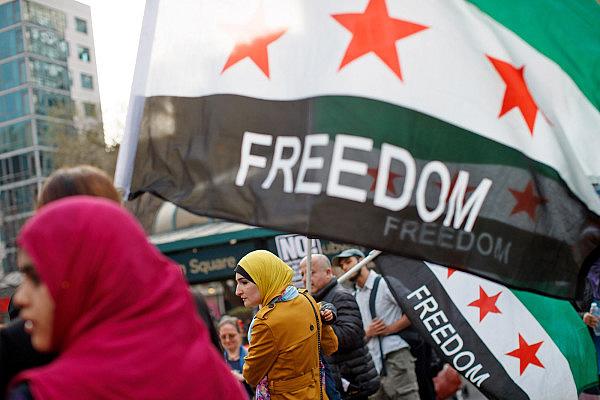Timeline: An uncertain year for immigrants
Rebecca Adams reported this story with support from the Fund for Journalism on Child Well-Being, a program of the University of Southern California Center for Health Journalism.
Image

A “Women for Syria” vigil in New York City last April. (Drew Angerer/Getty Images)
Published on
January 22, 2018
President Donald Trump took numerous immigration-related actions in his first year in office, including those summarized below. His actions followed an increase in deportations by President Barack Obama.
January 2017
An executive order blocked entry of all refugees for 120 days, Syrian refugees indefinitely and nationals from seven Muslim-majority countries for 90 days. After federal courts quickly blocked the ban, the administration scaled it back and issued a new executive order in March. In June, the U.S. Supreme Court allowed an even more scaled-back version affecting six nations to take effect. In September, as the travel ban was set to expire, the administration released another version, targeting primarily Muslim-majority countries as well as Chad, North Korea and Venezuela. This version prevented entry of most nationals indefinitely (except Venezuela, which focuses on some government officials and their families) and bolstered screening policies. In December, the Supreme Court let the administration’s ban take effect but did not rule on the merits. It continues to be challenged in two federal appeals courts on its way to the high court. Trump issued another policy in October requiring refugees from 11 Muslim-majority countries, many of them covered by the other ban, to undergo extreme vetting before entering the U.S. and preventing refugees’ families from joining them in the U.S. This ban is also being challenged in federal courts.
Another executive order broadened the category of undocumented immigrants who are “priorities for removal.” The Obama administration focused on people charged with or convicted of a crime. The Trump administration also prioritized people who “committed acts that constitute a chargeable offense,” no matter whether they were convicted. The order canceled federal grants for “sanctuary cities,” which do not cooperate with immigration enforcement, but a federal court killed that provision after legal challenges. The administration later narrowed the scope of the provision, but cities continue to fight the new grant limits.
May 2017
Trump did not extend the expiring Temporary Protected Status protections for Guinea, Liberia and Sierra Leone.
September 2017
The administration ended the Deferred Action for Childhood Arrivals, or DACA, program as of March 2018 for about 690,000 undocumented youth who came to the U.S. as children. DACA allowed them to stay in the country and work for two-year renewable periods. The permits of recipients, known as Dreamers, remain in force until they expire.
The administration ended Temporary Protected Status protections for Sudan, effective Nov. 2, 2018. People in the U.S. under this category have to get a different legal immigration status or leave.
November 2017
Trump ended TPS protections for Nicaragua, effective Jan. 5, 2019.
The administration stopped taking applications for Central American Minors program refugees on Nov. 9, 2017.
The administration ended TPS designation for Haiti, effective July 22, 2019.
January 2018
The administration ended TPS protections for El Salvador, effective Sept. 9, 2019.
[This story was originally published by CQ.]

